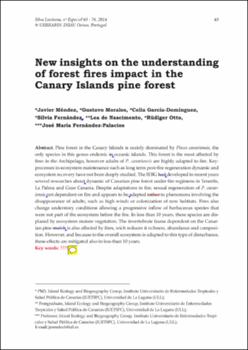New insights on the understanding of forest fires impact in the Canary Islands pine forest
Fecha
2014Resumen
Pine forest in the Canary Islands is mainly dominated by Pinus canariensis, the
only species in this genus endemic in oceanic islands. This forest is the most affected by
fires in the Archipelago, however adults of P. canariensis are highly adapted to fire. Keyprocesses
in ecosystem maintenance such as long term post-fire regeneration dynamic and
ecosystem recovery have not been deeply studied. The IEBG had developed in recent years
several researches about dynamic of Canarian pine forest under fire regimens in Tenerife,
La Palma and Gran Canaria. Despite adaptations to fire, sexual regeneration of P. canariensis
not dependent on fire and appears to be adapted rather to phenomena involving the
disappearance of adults, such as high winds or colonization of new habitats. Fires also
change understory conditions allowing a progressive inflow of herbaceous species that
were not part of the ecosystem before the fire. In less than 10 years, these species are displaced
by ecosystem mature vegetation. The invertebrate fauna dependent on the Canarian
pine mulch is also affected by fires, wich reduces it richness, abundance and composition.
However, and because to the overall ecosystem is adapted to this type of disturbance,
these effects are mitigated also in less than 10 years.






